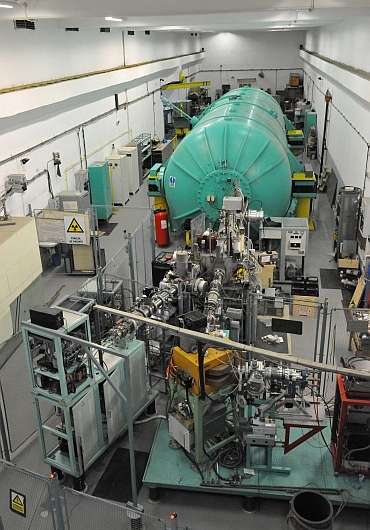The first light atomic nucleus with a second face

To some degree of approximation, atomic nuclei are spherical, though distorted to a greater or lesser extent. When the nucleus is excited, its shape may change, but only for an extremely brief moment, after which it returns to its original state. A relatively permanent 'second face' of atomic nuclei has so far only been observed in the most massive elements. Recently, physicists from Poland, Italy, Japan, Belgium and Romania have for the first time registered this phenomenon in a light nucleus.
Atomic nuclei can change their shape depending on the amount of energy they possess or the speed at which they spin. Changes related only to the addition of energy (and not accounting for spin) are relatively stable only in nuclei of the most massive elements. Now, it turns out that the nuclei of much lighter elements such as nickel can also persist a little longer in their new shape.
The calculations necessary for the preparation of the experiment proved to be so complex that a computer infrastructure of about one million processors was required to perform them. The effort has been reported in the journal Physical Review Letters.
Constructed of protons and neutrons, atomic nuclei are generally considered to be spherical structures, but can be flattened or elongated along one, two, or sometimes three axes. What's more, atomic nuclei can change their deformation depending on the amount of energy they possess, even when they are not spinning.
"When an atomic nucleus is supplied with the right amount of energy, it can transition into a state with a different shape deformation than is typical for the basic state. However, this new deformation, illustratively speaking, is very unstable. Just like a ball returns to its original shape after squeezing it, so the nucleus returns to its original form, but it does so much, much faster—in billionths of a billionth of a second or an even shorter time. So instead of talking about the second face of the atomic nucleus, it's probably better to talk about just a grimace," explains Prof. Bogdan Fornal.
In the last few decades, evidence has accumulated confirming that relatively stable nuclei with a deformed shape can be present in a small number of elements. Measurements have shown that the nuclei of some actinides—elements with atomic numbers from 89 (actinium) to 103 (lawrencium)—are capable of maintaining their 'second face' even tens of millions of times longer than other nuclei. Actinides are quite massive, with protons and neutrons totaling well above 200. Up to now, among the non-spinning nuclei of lighter elements, an excited state with a deformed shape characterized by high stability has never been observed.
"We pointed out that two theoretical models of nuclear excitation predict the existence of relatively stable states with deformed shapes in the nuclei of light elements. Later, a third model appeared that also led to similar conclusions. Our attention was drawn to nickel-66, because it was present in the predictions of all three models," recalls Prof. Fornal.
The new experimental method proposed by Prof. Silvia Leoni (UniMi), combined with the computationally sophisticated Monte Carlo shell model developed by the Tokyo University theorists, enabled the design of appropriate, accurate measurements. The experiment was carried out at the 9 MV FN Pelletron Tandem accelerator operating in the Romanian National Institute of Physics and Nuclear Engineering (IFIN-HH).
In the experiment in Bucharest, a target of nickel-64 was fired with nuclei of oxygen-18. Relative to oxygen-16, which is the main (99.76%) isotope of atmospheric oxygen, these nuclei contain two additional neutrons. During the collisions, both the excess neutrons can be transferred to the nickel nuclei, resulting in the creation of nickel-66, the basic shape of which is almost an ideal sphere. With properly selected collision energies, a small portion of the Ni-66 nuclei thus formed achieve a certain state with a deformed shape which, as measurements showed, proved to be slightly more stable than all other excited states associated with significant deformation. In other words, the nucleus was in a local, deep minimum of potential.
"The extension of lifespan of the deformed shape of the Ni-66 nucleus is not as spectacular as that of the actinides. We recorded only five-fold growth. Nevertheless, the measurement was exceptional, because it was the first observation of its kind in light nuclei," says Prof. Fornal, who stresses that the measured delay times of return to the basic state correspond to an acceptable extent with the values provided by the new theoretical model. None of the earlier models of nuclear structure allowed for such detailed predictions. This suggests that the new theoretical approach should be helpful in describing several thousand nuclei that have not yet been discovered.
More information: S. Leoni et al, Multifaceted Quadruplet of Low-Lying Spin-Zero States in Ni66 : Emergence of Shape Isomerism in Light Nuclei, Physical Review Letters (2017). DOI: 10.1103/PhysRevLett.118.162502
Journal information: Physical Review Letters
Provided by The Henryk Niewodniczanski Institute of Nuclear Physics Polish Academy of Sciences



















